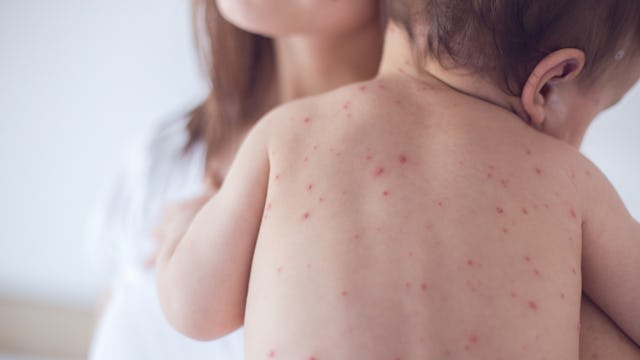107 Cases Of Measles Have Been Diagnosed Across 21 States So Far This Year

Measles outbreak continues to spread due to people not vaccinating
The Centers for Disease Control and Prevention just reported that more than 100 cases of measles — 107 to be exact — have been reported this year across 21 states and the District of Columbia. It’s only August and in 2017, there were 115 cases total over 15 states and I’m no statistician, but it looks like we’re headed for a sizable increase compared to last year before 2018 is up.
The CDC says the disease is contagious through the air when the infected cough or sneeze. The symptoms, which can include high fever, red eyes, a full-body rash, and a stuffy nose, usually disappear in those infected after a couple of weeks. But for one or two children out of 1,000 who get measles will die, according to the CDC.
The 107 measles cases for 2018 were recorded up until July 14 and occurred in Arkansas, California, Connecticut, Florida, Illinois, Indiana, Kansas, Louisiana, Maryland, Michigan, Missouri, Nevada, New Jersey, New York, North Carolina, Oklahoma, Oregon, Pennsylvania, Tennessee, Texas, Washington and the District of Columbia.
Although this mid-year count is definitely high compared to the last few years, it’s still not trending nearly as badly as 2014, a year that saw a total of 667 cases in 27 states. Of the 2014 cases, 338 were linked to a single outbreak.
In other words, vaccinating everyone who’s medically able to be immunized is absolutely crucial when it comes to preventing large outbreaks. It’s areas with pockets of unvaccinated individuals that are seeing the worst of the outbreaks. The CDC says most of those who contract measles are not inoculated against the illness.
The CDC also notes in their report that measles are still common in Europe, Asia, the Pacific, and Africa. Travelers can bring them back to the U.S. where they spread most easily in areas with lower vaccination rates.
The measles vaccine (known as MMR, measles, mumps, rubella) is highly effective. Just one dose is 93 percent effective at preventing the disease for a vaccinated person coming into contact with it. A second dose brings that number to 97 percent. It’s recommended by the CDC for kids to receive their first dose between 12 and 15 months of age. The second, between ages four and six.
The World Health Organization reports that measles are one of the deadliest childhood illnesses globally with 450 kids dying from the disease every day. Unvaccinated infants are particularly vulnerable to infection, which is why the CDC emphasizes the importance of herd immunity. We need to protect those who are unable to be vaccinated — or else these outbreaks will continue and possibly, get worse.
This article was originally published on